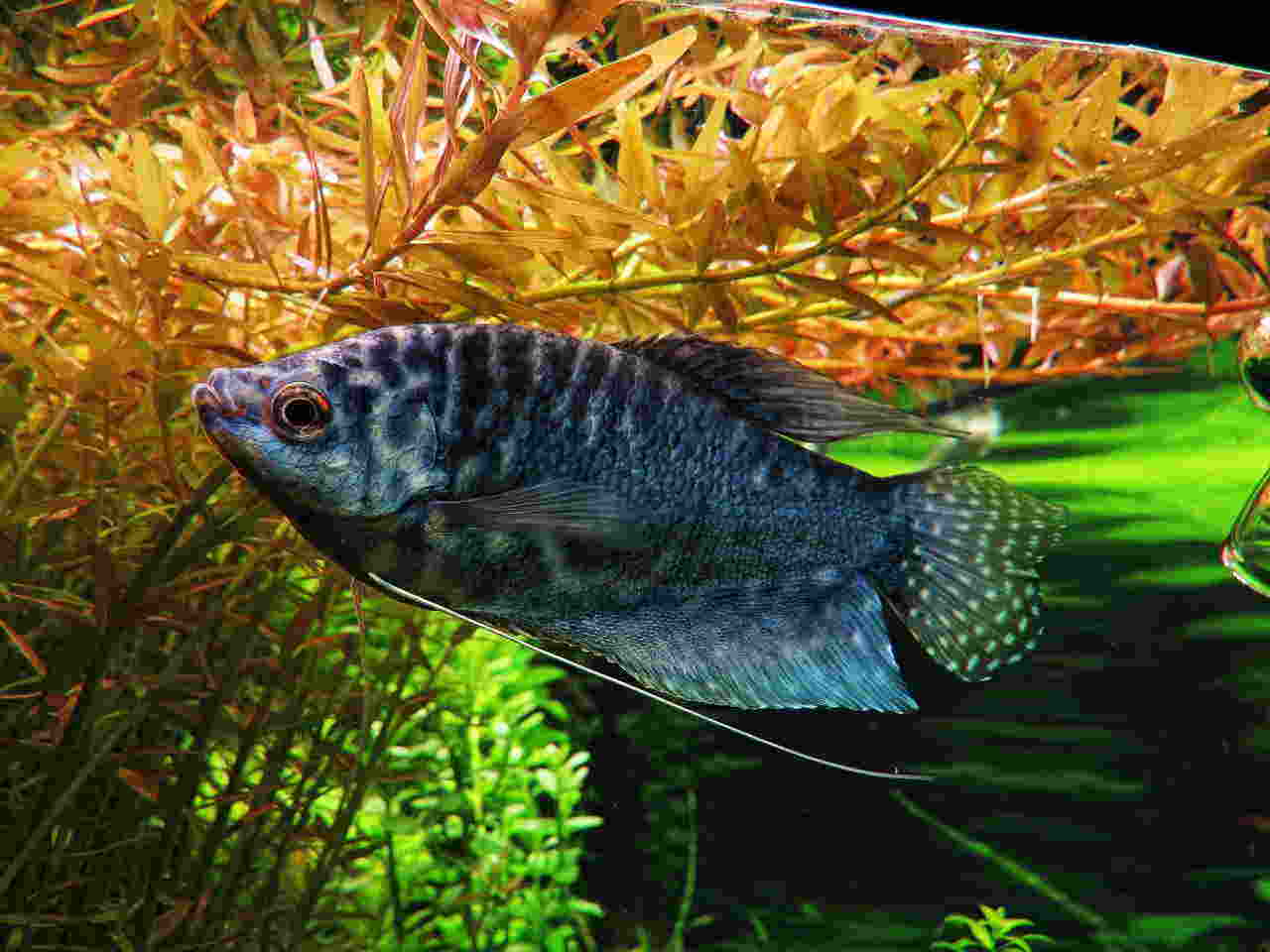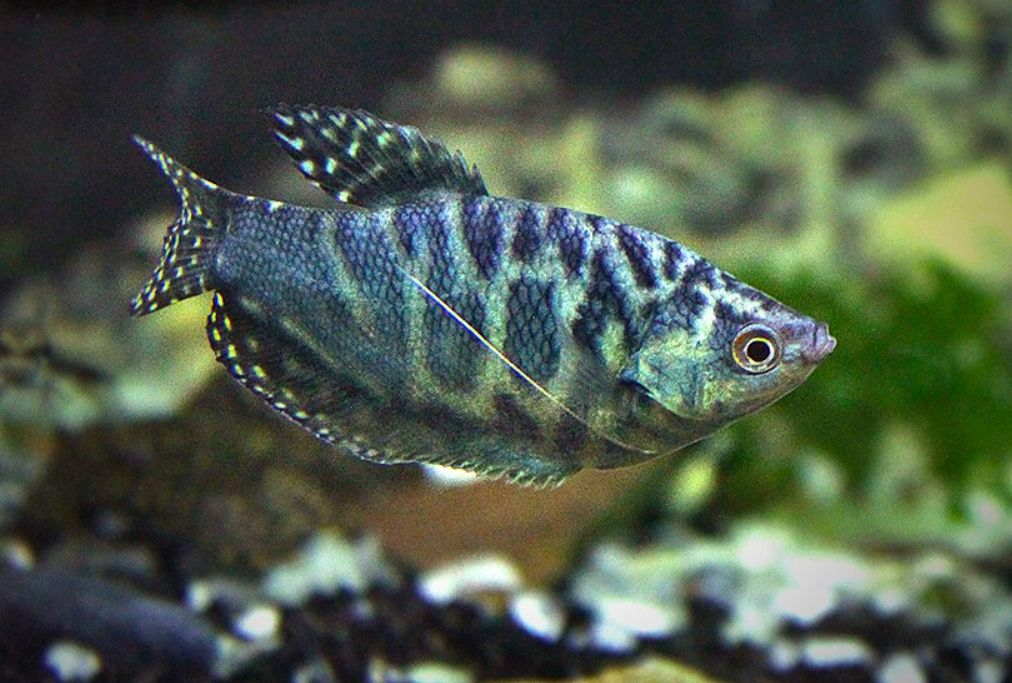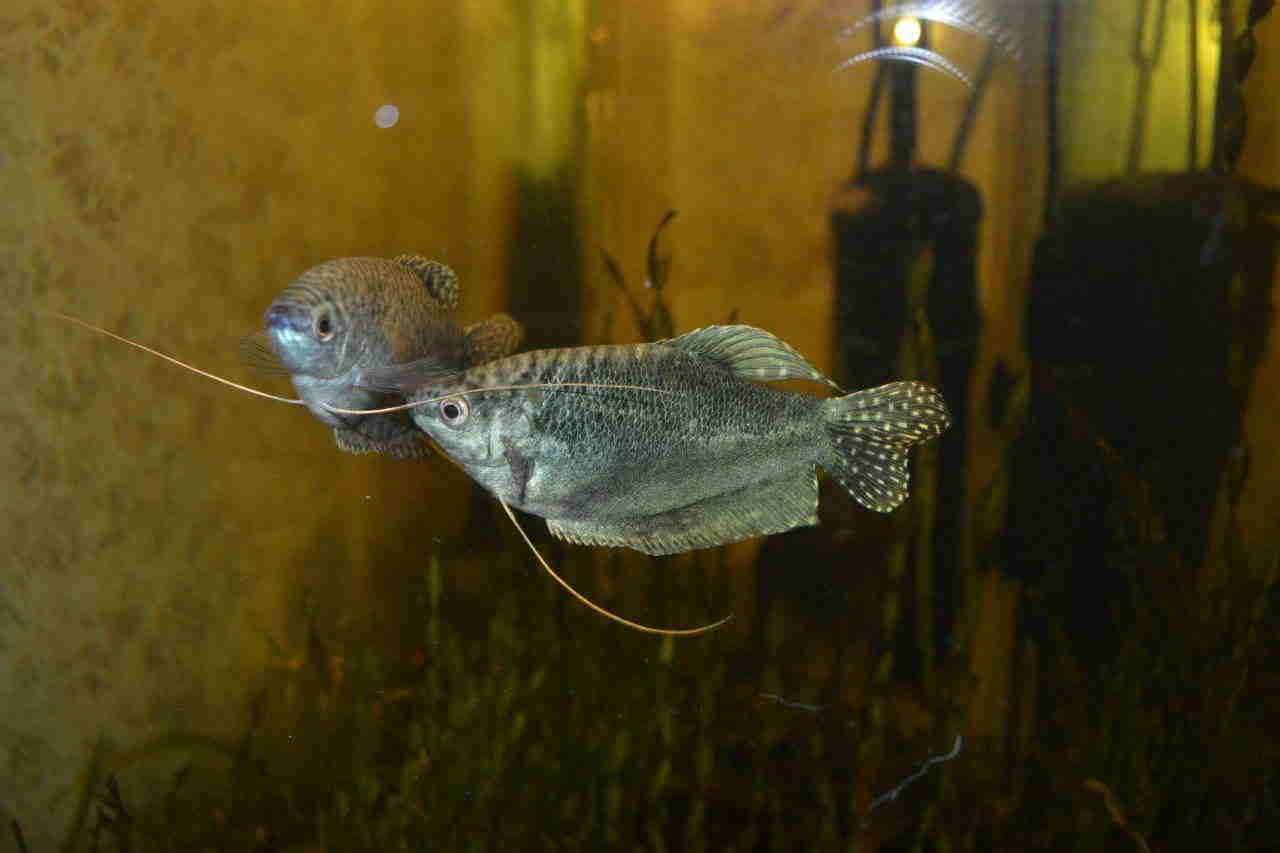Opaline gouramis are a stunning color morph of three spot gouramis, renowned for their vibrant hues and unique patterns. As members of the Anabantoidei suborder, they are often referred to as labyrinth fish, known for their ability to breathe air.
Their captivating appearance, peaceful demeanor, and engaging behaviors make opaline gouramis a popular choice among aquarium enthusiasts. To ensure their health and well-being, it is essential to provide a suitable environment and proper care. This includes maintaining appropriate water conditions and a well-planted tank, which allows them to thrive and display their natural behaviors.

Contents
Habitat in the wild
The opaline gourami belongs to the family Osphronemidae, also known as the gourami family, which encompasses various species of freshwater labyrinth fish. This family is part of the order Perciformes, which includes many popular aquarium fish.
In addition to opaline gouramis, other well-known species from the Osphronemidae family include pearl gourami, dwarf gourami, kissing gourami, and sparkling gourami. Each of these species brings its unique charm to aquariums.
Bringing opaline gouramis to Europe initially posed significant challenges. Caught in Thailand and Vietnam, these fish struggled to survive the long transportation in wooden barrels filled to the brim with water. During that era, few people understood the labyrinth fish’s unique need for atmospheric air. While in Paris, Paul Carbonnier successfully bred paradise fish, highlighting the potential of these species.
After many unsuccessful attempts, opaline gouramis were deemed troublesome, and interest in importing them waned for two decades. Observers were puzzled because these fish thrived in various environments, from rain barrels to muddy water.
It wasn’t until the late 19th century that an observant European recognized that these fish often came to the surface to gulp air. Following advice from his Indonesian guide, he filled his transportation barrels only two-thirds full and left them loosely covered. This method allowed several thousand gouramis to arrive at their destination without losses.
Thus, Trichopodus trichopterus made its debut in Europe in 1896. The fish quickly gained popularity and were successfully bred in captivity. While opaline gouramis are a color morph not found in the wild, their ancestor thrives in various freshwater habitats.
Description
Body
The opaline gourami features an elongated, laterally flattened body with large, rounded fins. Its pelvic fins have evolved into delicate barbs equipped with sensitive receptors, allowing the fish to gather information about its surroundings.
Like all labyrinth fish, the opaline gourami can breathe atmospheric oxygen, enabling it to survive in less-than-ideal conditions. This ability is attributed to a specialized respiratory organ known as the “labyrinth organ,” located in the epibranchial space. This organ is formed by folds of tissue that cover the bone, resembling the lungs of land animals.
The labyrinth organ is rich in capillary vessels and plays a crucial role in respiration. Without access to atmospheric air, labyrinth fish can suffocate, as their gills are not capable of extracting enough oxygen from water alone.
Color
The opaline gourami is renowned for its stunning coloration, especially in males when they are excited. Their bodies exhibit a striking dark blue hue, accented by scattered dark spots that create a marble-like pattern, which is how they earned their name.
Size
The opaline gourami can grow to a maximum size of about 15 cm (6 in), though in aquariums, they usually reach sizes closer to the lower end of that range, typically between 10 to 12 centimeters (4 to 5 inches). Males are generally slightly larger than females and often have more elongated and pointed dorsal fins, adding to their distinct appearance.
Lifespan
The average lifespan of an opaline gourami is around 4 to 6 years. However, with proper care and a healthy environment, some individuals can live longer, occasionally reaching up to 7 years or more in rare cases.
| Characteristic | Description |
|---|---|
| Scientific Name | Trichopodus trichopterus |
| Common Names | Opaline Gourami, Three-spot Gourami |
| Family | Osphronemidae (Gourami family) |
| Native Region | Southeast Asia (Thailand, Malaysia, Indonesia, etc.) |
| Habitat | Slow-moving or standing freshwater with vegetation |
| Size | Up to 6 inches (15 cm) in length |
| Lifespan | 4 to 6 years in captivity |
| Body Shape | Elongated, slightly flattened |
| Body Colors | Various shades of blue, green, and silver |
| Dorsal/Anal Fins | Long, flowing dorsal and anal fins |
| Temperament | Generally peaceful and social |
| Labyrinth Organ | Allows them to breathe atmospheric air |
| Tank Size | Minimum 30 gallons for one Gourami |
| Water Parameters | pH: 6.0 – 7.5, Temperature: 75°F – 82°F (24°C – 28°C) |
| Diet | Omnivorous – Flakes, pellets, live/frozen foods |
| Breeding Behavior | Bubble nest builders, male guards eggs and fry |

Difficulties in keeping
The opaline gourami is relatively easy to care for, making it a great choice for beginners. It adapts well to various tank conditions and isn’t particularly fussy about its diet. While they thrive in community tanks, it’s important to note that males can be territorial and may engage in skirmishes with each other or other fish in the tank.
Keeping in a tank
It’s essential to have a lid on the tank for opaline gouramis, as they, like all labyrinth fish, frequently surface to access atmospheric air. Maintaining a consistent air temperature just slightly different from the water temperature helps create a stable environment for their well-being.
Water parameters
Opaline gouramis and their color morphs are surprisingly undemanding. They thrive in a wide range of water temperatures, with an optimal range of 75–81 °F (24–27 °C). The chemical composition of the tank water is not overly critical; a pH between 6 and 7, which is neutral to slightly acidic, is ideal for their health.
Tank size
The minimum recommended tank size for keeping opaline gouramis is 30 gallons (113 liters). A larger aquarium not only provides ample swimming space but also minimizes waste buildup, leading to improved water quality.
Opaline gouramis are active fish that thrive in spacious environments where they can explore and establish their territories. In a larger tank, you can incorporate various hiding spots and arrange plants to mimic their natural habitat, which helps reduce stress and encourages healthier behavior.
If you plan to keep multiple opaline gouramis or introduce other fish to the tank, consider their compatibility and space needs. A well-planned community tank can create a more stable and harmonious environment, promoting the overall health of all inhabitants.
Diet
The opaline gourami is an omnivorous fish that primarily feeds on insects and their larvae in the wild. In an aquarium setting, they can thrive on a varied diet that includes live, frozen, and artificial foods. High-quality flakes or granules can serve as the foundation of their diet, providing essential nutrients.
For a well-rounded diet, consider offering live foods such as brine shrimp or daphnia, as well as frozen options like bloodworms. This variety not only meets their nutritional needs but also keeps them engaged and active.
Tank mates
Opaline gouramis are known for their peaceful and calm demeanor, making them excellent companions in a community tank. They thrive best when kept in groups, particularly with one male and multiple females. This arrangement helps prevent males from becoming aggressive toward each other, which can lead to injuries.
While opaline gouramis are generally compatible with a wide range of fish, it’s important to avoid pairing them with aggressive species or fin-nippers. Fish like larger cichlids, aggressive barbs, and territorial species can cause stress and damage to the delicate fins of opaline gouramis. Instead, consider keeping them with other peaceful species such as tetras or rasboras for a harmonious aquarium environment.
Here are some suitable tank mates:
- Peaceful Community Fish: Small to medium-sized peaceful community fish can do well with opaline gouramis. Some examples include:
- Tetras (e.g., Neon Tetras, Ember Tetras)
- Rasboras (e.g., Harlequin Rasboras, Chili Rasboras)
- Corydoras Catfish
- Otocinclus Catfish
- Dwarf Cichlids (e.g., German Blue Ram, Apistogramma cacatuoides)
- Some peaceful barbs (e.g., Cherry Barbs, Tinfoil Barbs)
- Bottom Dwellers: Some bottom-dwelling fish can complement Opaline Gouramis as well, such as:
- Kuhli Loaches
- Bristlenose Plecos
- Snails and shrimp (e.g., Cherry Shrimp, Amano Shrimp)
Gender differences: male vs female
To distinguish between male and female opaline gouramis, raising juveniles from a young age is a reliable approach. Male opaline gouramis have a long, pointed dorsal fin that, when lowered, extends to the base of their tail fin. In contrast, females possess a shorter dorsal fin.
Additionally, reproductive females tend to be smaller than males and exhibit a more rounded abdomen, especially when they are ready to spawn. Understanding these differences is helpful for aquarists looking to maintain a balanced community tank or breed their opaline gouramis.

Breeding
To successfully breed opaline gouramis, set up a specialized spawning tank with a minimum capacity of 5 gallons. Include small-leaved floating plants, and ensure the water is fresh and has been allowed to settle for 2–3 days before introducing the fish.
To encourage breeding, raise the water temperature to 26–28°C. Aim for a water hardness of 6–7 pH and an acidity of up to 15 dH. It’s essential to provide a peaceful environment, so consider covering the tank walls with paper or cloth.
The breeding process begins when the male constructs a bubble nest on the water’s surface, typically around 8 cm in diameter. Once the nest is ready, the male will court the female. During spawning, he curves his body to embrace the female, pressing her abdomen to release eggs, which float to the surface. An opaline gourami can lay up to 1,000 eggs during this process.
Immediately after spawning, remove the female from the tank, as the male will take care of the eggs. The larvae will hatch in about two days. The male diligently watches over the young, returning any that drift away back to the nest.
After four days, when the larvae begin to spread throughout the tank, it’s time to remove the male to prevent him from eating the fry. Feed the juveniles infusorians and rotifers, as these are the smallest forms of live food suitable for them.
Once the fry’s labyrinth organ develops, they will start coming to the surface for air. Gradually increase the water level over time. Keep in mind that juveniles may grow at different rates, which can lead to cannibalism; therefore, it’s important to sort them by size regularly.
To maintain water quality, replace half of the tank water weekly with clean, settled, and aerated water. This routine will help ensure a healthy environment for your growing opaline gouramis.